
Illustrative Math Alignment: Grade 6 Unit 8
Data Sets and Distributions
Lesson 11: Finding and Interpreting the Mean as the Balance Point
Use the following Media4Math resources with this Illustrative Math lesson.
| Thumbnail Image | Title | Body | Curriculum Nodes |
|---|---|---|---|

|
Quizlet Flash Cards: The Average of Four Numbers, Set 02 | In this set of 10 interactive flash cards find the mean of four numbers. Press the Options button to decide how to display the flash cards. Press the Play button to auto-play the sequence of flash cards. Press Shuffle to change the order of the cards. Note: The download is the teacher's guide for using Media4Math's Quizlet Flash Cards. Related ResourcesTo see the complete collection of Quizlet Flash Cards on this topic, click on this link: https://bit.ly/3cA1iv1 |
Data Analysis |

|
Quizlet Flash Cards: The Average of Four Numbers, Set 03 | In this set of 10 interactive flash cards find the mean of four numbers. Press the Options button to decide how to display the flash cards. Press the Play button to auto-play the sequence of flash cards. Press Shuffle to change the order of the cards. Note: The download is the teacher's guide for using Media4Math's Quizlet Flash Cards. Related ResourcesTo see the complete collection of Quizlet Flash Cards on this topic, click on this link: https://bit.ly/3cA1iv1 |
Data Analysis |

|
Quizlet Flash Cards: The Average of Four Numbers, Set 04 | In this set of 10 interactive flash cards find the mean of four numbers. Press the Options button to decide how to display the flash cards. Press the Play button to auto-play the sequence of flash cards. Press Shuffle to change the order of the cards. Note: The download is the teacher's guide for using Media4Math's Quizlet Flash Cards. Related ResourcesTo see the complete collection of Quizlet Flash Cards on this topic, click on this link: https://bit.ly/3cA1iv1 |
Data Analysis |

|
Quizlet Flash Cards: The Average of Four Numbers, Set 05 | In this set of 10 interactive flash cards find the mean of four numbers. Press the Options button to decide how to display the flash cards. Press the Play button to auto-play the sequence of flash cards. Press Shuffle to change the order of the cards. Note: The download is the teacher's guide for using Media4Math's Quizlet Flash Cards. Related ResourcesTo see the complete collection of Quizlet Flash Cards on this topic, click on this link: https://bit.ly/3cA1iv1 |
Data Analysis |

|
Video Transcript: Algebra Applications: Variables and Equations, Segment 2: Honey Production | Video Transcript: Algebra Applications: Variables and Equations, Segment 2: Honey Production
This is the transcript for the video of same title. Video contents: Honey bees not only produce a tasty treat, they also help pollinate flowering plants that provide much of the food throughout the world. So, when in 2006 bee colonies started dying out, scientists recognized a serious problem. Analyzing statistics from honey bee production allows for a mathematical analysis of the so-called Colony Collapse Disorder. |
Applications of Equations and Inequalities |

|
Math Example--Measures of Central Tendency--Mean: Example 1 | Math Example--Measures of Central Tendency--Mean: Example 1TopicMeasures of Central Tendency DescriptionThis example demonstrates how to calculate the mean of a dataset, a fundamental concept in statistics. The mean, often referred to as the average, is a measure of central tendency that provides insight into the typical value of a dataset. By visually presenting the calculation process, students can better grasp the concept and its application in real-world scenarios. |
Data Analysis |
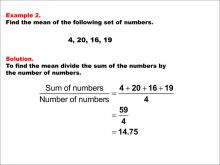
|
Math Example--Measures of Central Tendency--Mean: Example 2 | Math Example--Measures of Central Tendency--Mean: Example 2TopicMeasures of Central Tendency DescriptionThis example builds upon the concept of calculating the mean, introducing a slightly more complex dataset. It illustrates how the mean remains an effective measure of central tendency even as the numbers in the dataset become more varied. The visual representation helps students understand the step-by-step process of summing all values and dividing by the count of numbers. |
Data Analysis |
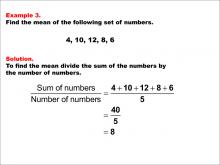
|
Math Example--Measures of Central Tendency--Mean: Example 3 | Math Example--Measures of Central Tendency--Mean: Example 3TopicMeasures of Central Tendency DescriptionThis example further explores the concept of calculating the mean, introducing a dataset with a different range of values. It demonstrates how the mean can be used to find a central value even when the numbers in the dataset are more spread out. The visual representation continues to reinforce the process of summing all values and dividing by the count of numbers. |
Data Analysis |
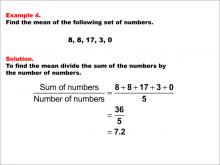
|
Math Example--Measures of Central Tendency--Mean: Example 4 | Math Example--Measures of Central Tendency--Mean: Example 4TopicMeasures of Central Tendency DescriptionThis example continues to reinforce the concept of calculating the mean, presenting a new set of numbers for analysis. It emphasizes the consistency of the process: summing all values and dividing by the count of numbers, regardless of the specific values in the dataset. The visual representation helps students see how different numbers can still lead to a single, representative value. |
Data Analysis |
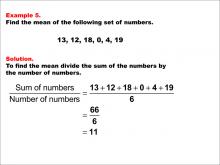
|
Math Example--Measures of Central Tendency--Mean: Example 5 | Math Example--Measures of Central Tendency--Mean: Example 5TopicMeasures of Central Tendency DescriptionThis fifth example in the series on calculating the mean introduces yet another set of numbers, further reinforcing the universality of the concept. It demonstrates how the process of finding the mean remains consistent: summing all values and dividing by the count of numbers, regardless of the specific values or the size of the dataset. The visual representation continues to aid in understanding the step-by-step process. |
Data Analysis |
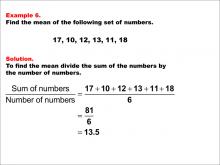
|
Math Example--Measures of Central Tendency--Mean: Example 6 | Math Example--Measures of Central Tendency--Mean: Example 6TopicMeasures of Central Tendency DescriptionThis sixth example in the series on calculating the mean introduces a new set of numbers, further solidifying the concept and its application. It reiterates the consistent process of finding the mean: summing all values and dividing by the count of numbers, regardless of the specific values in the dataset. The visual representation continues to support understanding of each step in the calculation. |
Data Analysis |
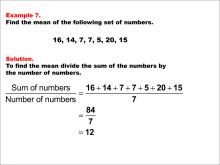
|
Math Example--Measures of Central Tendency--Mean: Example 7 | Math Example--Measures of Central Tendency--Mean: Example 7TopicMeasures of Central Tendency DescriptionThis seventh example in the series on calculating the mean presents yet another set of numbers, further reinforcing the concept and its application in various scenarios. It continues to demonstrate the consistent process of finding the mean: summing all values and dividing by the count of numbers, regardless of the specific values or the size of the dataset. The visual representation aids in understanding each step of the calculation process. |
Data Analysis |
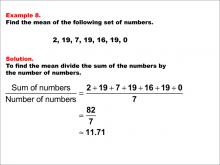
|
Math Example--Measures of Central Tendency--Mean: Example 8 | Math Example--Measures of Central Tendency--Mean: Example 8TopicMeasures of Central Tendency DescriptionThis example demonstrates the calculation of the mean for a set of numbers: 2, 19, 7, 19, 16, 19, and 0. The process involves summing all values and dividing by the count of numbers, resulting in an average of approximately 11.71. This example reinforces the concept of finding a central value that represents the entire dataset. |
Data Analysis |
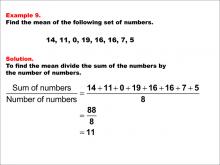
|
Math Example--Measures of Central Tendency--Mean: Example 9 | Math Example--Measures of Central Tendency--Mean: Example 9TopicMeasures of Central Tendency DescriptionThis example illustrates the calculation of the mean for the numbers 14, 11, 0, 19, 16, 16, 7, and 5. The process involves summing all values (88) and dividing by the count of numbers (8), resulting in a mean of 11. This example showcases how the mean can provide a central value that represents a diverse set of numbers, including zero. |
Data Analysis |
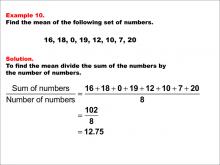
|
Math Example--Measures of Central Tendency--Mean: Example 10 | Math Example--Measures of Central Tendency--Mean: Example 10TopicMeasures of Central Tendency DescriptionThis example demonstrates the calculation of the mean for the numbers 16, 18, 0, 19, 12, 10, 7, and 20. The process involves summing all values (102) and dividing by the count of numbers (8), resulting in a mean of 12.75. This example highlights how the mean can provide a representative value for a dataset that includes both high and low numbers, including zero. |
Data Analysis |
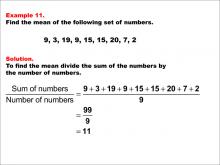
|
Math Example--Measures of Central Tendency--Mean: Example 11 | Math Example--Measures of Central Tendency--Mean: Example 11TopicMeasures of Central Tendency DescriptionThis example illustrates the calculation of the mean for the numbers 9, 3, 19, 9, 15, 15, 20, 7, and 2. The process involves summing all values (99) and dividing by the count of numbers (9), resulting in a mean of 11. This example demonstrates how the mean can provide a central value that represents a dataset with repeated numbers and a wide range of values. |
Data Analysis |
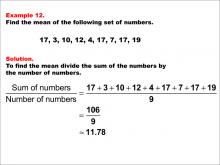
|
Math Example--Measures of Central Tendency--Mean: Example 12 | Math Example--Measures of Central Tendency--Mean: Example 12TopicMeasures of Central Tendency DescriptionThis example demonstrates the calculation of the mean for the numbers 17, 3, 10, 12, 4, 17, 7, 17, and 19. The process involves summing all values (106) and dividing by the count of numbers (9), resulting in a mean of approximately 11.78. This example showcases how the mean can provide a representative value for a dataset that includes repeated numbers and a wide range of values. |
Data Analysis |
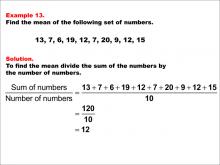
|
Math Example--Measures of Central Tendency--Mean: Example 13 | Math Example--Measures of Central Tendency--Mean: Example 13TopicMeasures of Central Tendency DescriptionThis example illustrates the calculation of the mean for the numbers 13, 7, 6, 19, 12, 7, 20, 9, 12, and 15. The process involves summing all values (120) and dividing by the count of numbers (10), resulting in a mean of 12. This example demonstrates how the mean can provide a central value that represents a dataset with repeated numbers and a wide range of values. |
Data Analysis |

|
Math Example--Measures of Central Tendency--Mean: Example 14 | Math Example--Measures of Central Tendency--Mean: Example 14TopicMeasures of Central Tendency DescriptionThis example demonstrates the calculation of the mean for the numbers 10, 2, 7, 16, 16, 17, 3, 10, 18, and 15. The process involves summing all values (114) and dividing by the count of numbers (10), resulting in a mean of 11.4. This example showcases how the mean can provide a representative value for a dataset that includes repeated numbers and a wide range of values. |
Data Analysis |
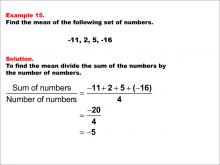
|
Math Example--Measures of Central Tendency--Mean: Example 15 | Math Example--Measures of Central Tendency--Mean: Example 15TopicMeasures of Central Tendency DescriptionThis example illustrates the calculation of the mean for the numbers -11, 2, 5, and -16. The process involves summing all values (-20) and dividing by the count of numbers (4), resulting in a mean of -5. This example is particularly important as it demonstrates how to handle negative numbers when calculating the mean, a concept that often challenges students. |
Data Analysis |
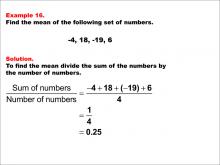
|
Math Example--Measures of Central Tendency--Mean: Example 16 | Math Example--Measures of Central Tendency--Mean: Example 16TopicMeasures of Central Tendency DescriptionThis example demonstrates the calculation of the mean for the numbers -4, 18, -19, and 6. The process involves summing all values (1) and dividing by the count of numbers (4), resulting in a mean of 0.25. This example is particularly interesting as it shows how positive and negative numbers can nearly balance each other out, resulting in a mean close to zero. |
Data Analysis |
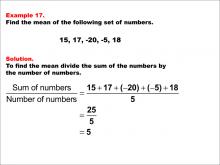
|
Math Example--Measures of Central Tendency--Mean: Example 17 | Math Example--Measures of Central Tendency--Mean: Example 17TopicMeasures of Central Tendency DescriptionThis example illustrates the calculation of the mean for the numbers 15, 17, -20, -5, and 18. The process involves summing all values (25) and dividing by the count of numbers (5), resulting in a mean of 5. This example is particularly instructive as it demonstrates how to handle a mix of positive and negative numbers, including some relatively large values in both directions. |
Data Analysis |
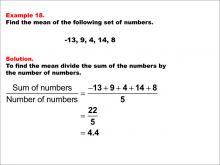
|
Math Example--Measures of Central Tendency--Mean: Example 18 | Math Example--Measures of Central Tendency--Mean: Example 18TopicMeasures of Central Tendency DescriptionThis example demonstrates the calculation of the mean for the numbers -13, 9, 4, 14, and 8. The process involves summing all values (22) and dividing by the count of numbers (5), resulting in a mean of 4.4. This example is particularly instructive as it shows how a single negative number can significantly impact the mean, even when most of the numbers are positive. |
Data Analysis |
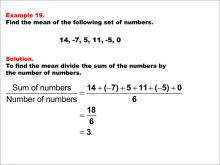
|
Math Example--Measures of Central Tendency--Mean: Example 19 | Math Example--Measures of Central Tendency--Mean: Example 19TopicMeasures of Central Tendency DescriptionThis example illustrates the calculation of the mean for the numbers 14, -7, 5, 11, -5, and 0. The process involves summing all values (18) and dividing by the count of numbers (6), resulting in a mean of 3. This example is particularly instructive as it demonstrates how to handle a mix of positive and negative numbers, including zero, in the calculation of the mean. |
Data Analysis |
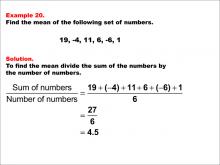
|
Math Example--Measures of Central Tendency--Mean: Example 20 | Math Example--Measures of Central Tendency--Mean: Example 20TopicMeasures of Central Tendency DescriptionThis example demonstrates the calculation of the mean for the numbers 19, -4, 11, 6, -6, and 1. The process involves summing all values (27) and dividing by the count of numbers (6), resulting in a mean of 4.5. This example is particularly instructive as it shows how positive and negative numbers interact in the calculation of the mean, resulting in a positive value despite the presence of negative numbers. |
Data Analysis |
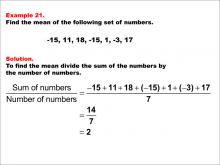
|
Math Example--Measures of Central Tendency--Mean: Example 21 | Math Example--Measures of Central Tendency--Mean: Example 21TopicMeasures of Central Tendency DescriptionThis example illustrates the calculation of the mean for the numbers -15, 11, 18, -15, 1, -3, and 17. The process involves summing all values (14) and dividing by the count of numbers (7), resulting in a mean of 2. This example is particularly instructive as it demonstrates how to handle a mix of positive and negative numbers, including repeated values, in the calculation of the mean. |
Data Analysis |
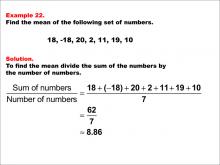
|
Math Example--Measures of Central Tendency--Mean: Example 22 | Math Example--Measures of Central Tendency--Mean: Example 22TopicMeasures of Central Tendency DescriptionThis example demonstrates the calculation of the mean for the numbers 18, -18, 20, 2, 11, 19, and 10. The process involves summing all values (62) and dividing by the count of numbers (7), resulting in a mean of approximately 8.86. This example is particularly instructive as it shows how a single large negative number can significantly impact the mean, even when most of the numbers are positive. |
Data Analysis |
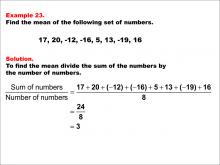
|
Math Example--Measures of Central Tendency--Mean: Example 23 | Math Example--Measures of Central Tendency--Mean: Example 23TopicMeasures of Central Tendency DescriptionThis example illustrates the calculation of the mean for the numbers 17, 20, -12, -16, 5, 13, -19, and 16. The process involves summing all values (24) and dividing by the count of numbers (8), resulting in a mean of 3. This example is particularly instructive as it demonstrates how to handle a mix of positive and negative numbers with varying magnitudes in the calculation of the mean. |
Data Analysis |
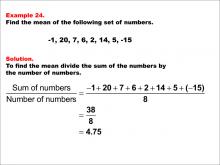
|
Math Example--Measures of Central Tendency--Mean: Example 24 | Math Example--Measures of Central Tendency--Mean: Example 24TopicMeasures of Central Tendency DescriptionThis example demonstrates the calculation of the mean for the numbers -1, 20, 7, 6, 2, 14, 5, and -15. The process involves summing all values (38) and dividing by the count of numbers (8), resulting in a mean of 4.75. This example is particularly instructive as it shows how a mix of positive and negative numbers, including some relatively large values in both directions, can interact to produce a mean that doesn't necessarily reflect the magnitude of the largest numbers in the set. |
Data Analysis |
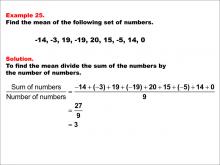
|
Math Example--Measures of Central Tendency--Mean: Example 25 | Math Example--Measures of Central Tendency--Mean: Example 25TopicMeasures of Central Tendency DescriptionThis example illustrates the calculation of the mean for the numbers -14, -3, 19, -19, 20, 15, -5, 14, and 0. The process involves summing all values (27) and dividing by the count of numbers (9), resulting in a mean of 3. This example is particularly instructive as it demonstrates how to handle a mix of positive and negative numbers, including zero, in the calculation of the mean. |
Data Analysis |
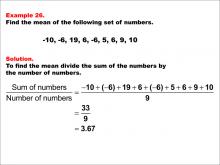
|
Math Example--Measures of Central Tendency--Mean: Example 26 | Math Example--Measures of Central Tendency--Mean: Example 26TopicMeasures of Central Tendency DescriptionThis example demonstrates the calculation of the mean for the numbers -10, -6, 19, 6, -6, 5, 6, 9, and 10. The process involves summing all values (33) and dividing by the count of numbers (9), resulting in a mean of approximately 3.67. This example is particularly instructive as it shows how positive and negative numbers interact in the calculation of the mean, resulting in a positive value despite the presence of negative numbers. |
Data Analysis |

|
Math Example--Measures of Central Tendency--Mean: Example 27 | Math Example--Measures of Central Tendency--Mean: Example 27TopicMeasures of Central Tendency DescriptionThis example illustrates the calculation of the mean for the numbers 10, -14, 14, 17, 20, -3, -20, -2, 11, and -3. The process involves summing all values (30) and dividing by the count of numbers (10), resulting in a mean of 3. This example is particularly instructive as it demonstrates how to handle a mix of positive and negative numbers, including some relatively large values in both directions, in the calculation of the mean. |
Data Analysis |
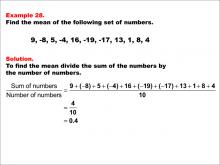
|
Math Example--Measures of Central Tendency--Mean: Example 28 | Math Example--Measures of Central Tendency--Mean: Example 28TopicMeasures of Central Tendency DescriptionThis example demonstrates the calculation of the mean for the numbers 9, -8, 5, -4, 16, -19, -17, 13, 1, 8, and 4. The process involves summing all values (4) and dividing by the count of numbers (10), resulting in a mean of 0.4. This example is particularly instructive as it shows how a mix of positive and negative numbers, including some relatively large values in both directions, can interact to produce a mean close to zero. |
Data Analysis |
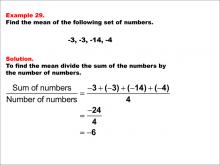
|
Math Example--Measures of Central Tendency--Mean: Example 29 | Math Example--Measures of Central Tendency--Mean: Example 29TopicMeasures of Central Tendency DescriptionThis example illustrates the calculation of the mean for the numbers -3, -3, -14, and -4. The process involves summing all values (-24) and dividing by the count of numbers (4), resulting in a mean of -6. This example is particularly instructive as it demonstrates how to handle a dataset consisting entirely of negative numbers in the calculation of the mean. |
Data Analysis |
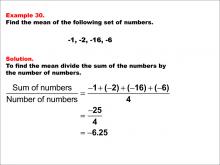
|
Math Example--Measures of Central Tendency--Mean: Example 30 | Math Example--Measures of Central Tendency--Mean: Example 30TopicMeasures of Central Tendency DescriptionThis example demonstrates the calculation of the mean for the numbers -1, -2, -16, and -6. The process involves summing all values (-25) and dividing by the count of numbers (4), resulting in a mean of -6.25. This example is particularly instructive as it shows how to handle a dataset consisting entirely of negative numbers, including one significantly larger negative value, in the calculation of the mean. |
Data Analysis |
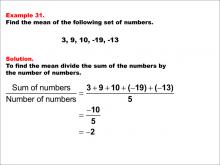
|
Math Example--Measures of Central Tendency--Mean: Example 31 | Math Example--Measures of Central Tendency--Mean: Example 31TopicMeasures of Central Tendency DescriptionThis example illustrates the calculation of the mean for the numbers 3, 9, 10, -19, and -13. The process involves summing all values (-10) and dividing by the count of numbers (5), resulting in a mean of -2. This example is particularly instructive as it demonstrates how to handle a mix of positive and negative numbers, including some relatively large values in both directions, in the calculation of the mean. |
Data Analysis |

|
Math Example--Measures of Central Tendency--Mean: Example 32 | Math Example--Measures of Central Tendency--Mean: Example 32TopicMeasures of Central Tendency DescriptionThis example demonstrates the calculation of the mean for a set of numbers. The process involves summing all values and dividing by the count of numbers. This example is particularly instructive as it reinforces the concept of finding a central value that represents the entire dataset, even when dealing with a mix of positive and negative numbers. |
Data Analysis |
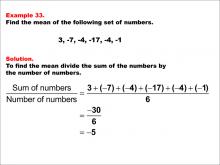
|
Math Example--Measures of Central Tendency--Mean: Example 33 | Math Example--Measures of Central Tendency--Mean: Example 33TopicMeasures of Central Tendency DescriptionThis example illustrates the calculation of the mean for another set of numbers. The process involves summing all values and dividing by the count of numbers. This example is particularly instructive as it continues to reinforce the concept of finding a central value that represents the entire dataset, potentially dealing with a different range or distribution of numbers than previous examples. |
Data Analysis |
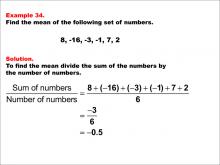
|
Math Example--Measures of Central Tendency--Mean: Example 34 | Math Example--Measures of Central Tendency--Mean: Example 34TopicMeasures of Central Tendency DescriptionThis example demonstrates the calculation of the mean for yet another set of numbers. The process involves summing all values and dividing by the count of numbers. This example is particularly instructive as it continues to reinforce the concept of finding a central value that represents the entire dataset, potentially dealing with a different range or distribution of numbers than previous examples. |
Data Analysis |
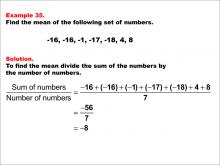
|
Math Example--Measures of Central Tendency--Mean: Example 35 | Math Example--Measures of Central Tendency--Mean: Example 35TopicMeasures of Central Tendency DescriptionThis example illustrates the calculation of the mean for a new set of numbers. The process involves summing all values and dividing by the count of numbers. This example is particularly instructive as it continues to reinforce the concept of finding a central value that represents the entire dataset, potentially dealing with a different range or distribution of numbers than previous examples. |
Data Analysis |
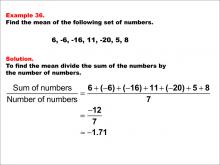
|
Math Example--Measures of Central Tendency--Mean: Example 36 | Math Example--Measures of Central Tendency--Mean: Example 36TopicMeasures of Central Tendency DescriptionThis example demonstrates the calculation of the mean for another set of numbers. The process involves summing all values and dividing by the count of numbers. This example is particularly instructive as it continues to reinforce the concept of finding a central value that represents the entire dataset, potentially dealing with a different range or distribution of numbers than previous examples. |
Data Analysis |

|
Math Example--Measures of Central Tendency--Mean: Example 37 | Math Example--Measures of Central Tendency--Mean: Example 37TopicMeasures of Central Tendency DescriptionThis example illustrates the calculation of the mean for a new set of numbers. The process involves summing all values and dividing by the count of numbers. This example is particularly instructive as it continues to reinforce the concept of finding a central value that represents the entire dataset, potentially dealing with a different range or distribution of numbers than previous examples. |
Data Analysis |

|
Math Example--Measures of Central Tendency--Mean: Example 38 | Math Example--Measures of Central Tendency--Mean: Example 38TopicMeasures of Central Tendency DescriptionThis example demonstrates the calculation of the mean for a set of numbers. The process involves summing all values and dividing by the count of numbers. This example is particularly instructive as it reinforces the concept of finding a central value that represents the entire dataset, potentially dealing with a different range or distribution of numbers than previous examples. |
Data Analysis |
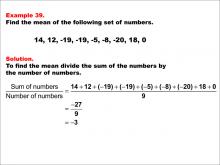
|
Math Example--Measures of Central Tendency--Mean: Example 39 | Math Example--Measures of Central Tendency--Mean: Example 39TopicMeasures of Central Tendency DescriptionThis example illustrates the calculation of the mean for a new set of numbers. The process involves summing all values and dividing by the count of numbers. This example is particularly instructive as it continues to reinforce the concept of finding a central value that represents the entire dataset, potentially dealing with a different range or distribution of numbers than previous examples. |
Data Analysis |
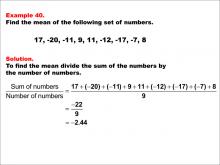
|
Math Example--Measures of Central Tendency--Mean: Example 40 | Math Example--Measures of Central Tendency--Mean: Example 40TopicMeasures of Central Tendency DescriptionThis example demonstrates the calculation of the mean for another set of numbers. The process involves summing all values and dividing by the count of numbers. This example is particularly instructive as it continues to reinforce the concept of finding a central value that represents the entire dataset, potentially dealing with a different range or distribution of numbers than previous examples. |
Data Analysis |
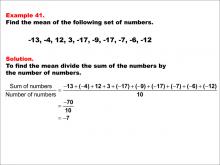
|
Math Example--Measures of Central Tendency--Mean: Example 41 | Math Example--Measures of Central Tendency--Mean: Example 41TopicMeasures of Central Tendency DescriptionThis example illustrates the calculation of the mean for a new set of numbers. The process involves summing all values and dividing by the count of numbers. This example is particularly instructive as it continues to reinforce the concept of finding a central value that represents the entire dataset, potentially dealing with a different range or distribution of numbers than previous examples. |
Data Analysis |
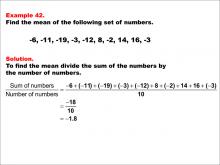
|
Math Example--Measures of Central Tendency--Mean: Example 42 | Math Example--Measures of Central Tendency--Mean: Example 42TopicMeasures of Central Tendency DescriptionThis example demonstrates the calculation of the mean for another set of numbers. The process involves summing all values and dividing by the count of numbers. This example is particularly instructive as it continues to reinforce the concept of finding a central value that represents the entire dataset, potentially dealing with a different range or distribution of numbers than previous examples. |
Data Analysis |
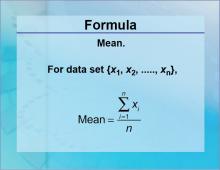
|
Formulas--Mean | Formulas--Mean
The formula for the Mean. This is part of a collection of math formulas. To see the complete collection of formulas, click on this link. Note: The download is a JPG file.Related ResourcesTo see resources related to this topic click on the Related Resources tab above. |
Data Analysis |

|
VIDEO: Ti-Nspire Mini-Tutorial, Video 70 | VIDEO: TI-Nspire Mini-Tutorial: Finding the Mean of a Data List
In this TI Nspire tutorial, the Spreadsheet and Calculator windows are used to find the mean of a data list. This video supports the TI-Nspire Clickpad and Touchpad. |
Data Analysis |